05 May 2022
![]() 14 mins Read
14 mins Read
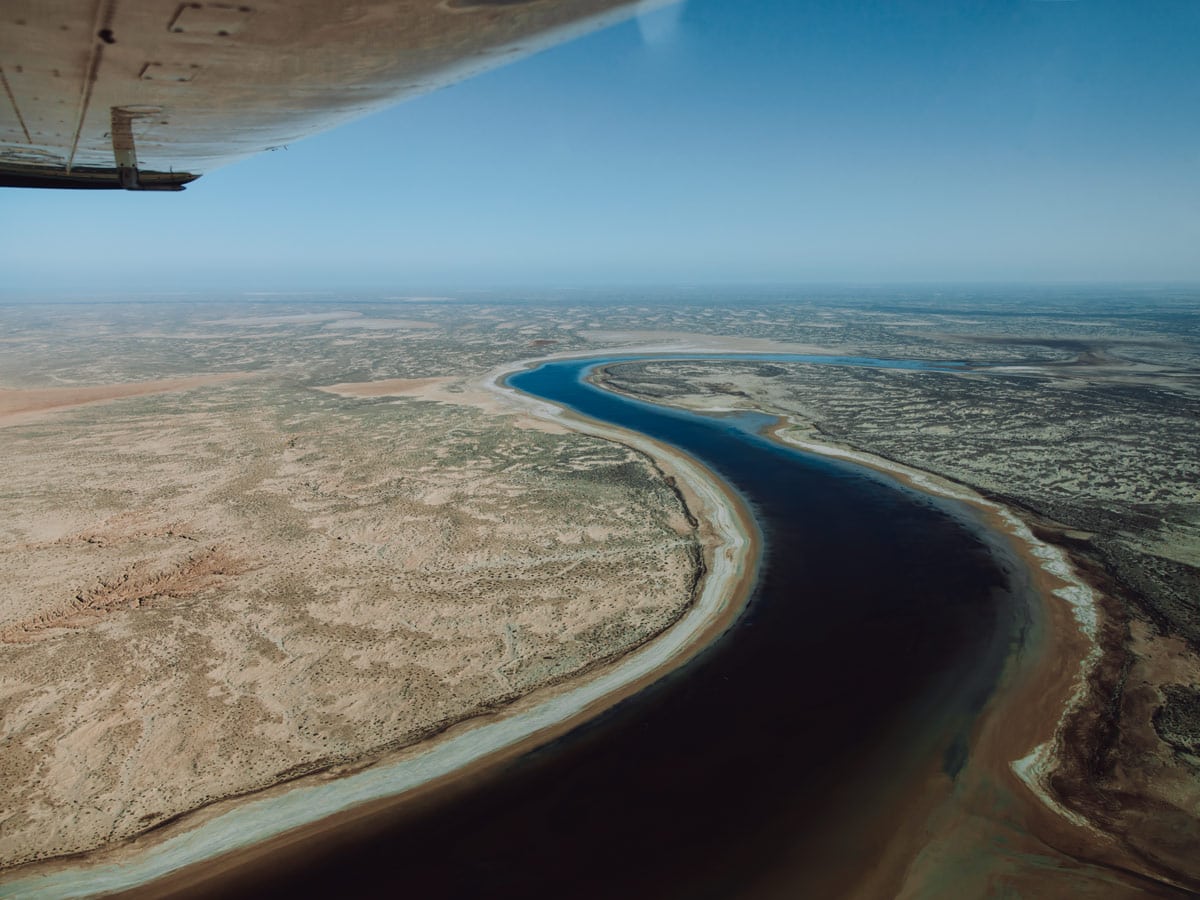
Jutting out into the Great Australian Bight, the dramatic coast of Fleurieu Peninsula is a nature lover’s paradise. Thirty minutes south of Adelaide, Port Noarlunga is a town nestled between the natural beauty of reef and river. Dubbed the ‘Great Southern Reef ’, its marine sanctuary zone is popular with divers, while Onkaparinga River National Park is hiking and kayaking territory.
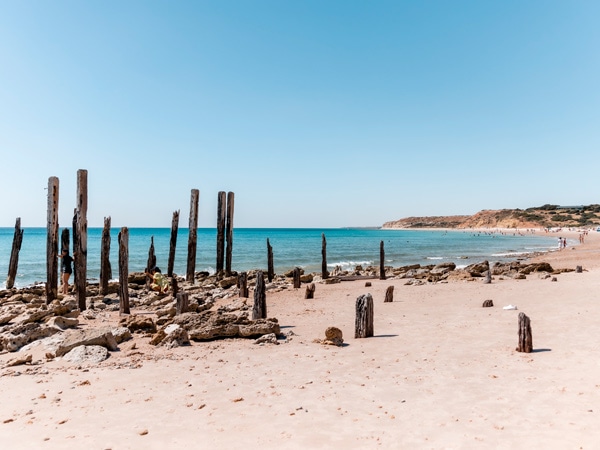
Make a stop at Port Willunga Beach. (Image: Mish and Kirk)
Further south, walk among the ruins of a 19th-century jetty and shipwreck at Port Willunga before dining at renowned ocean-front restaurant The Star of Greece. Then see where the rolling green hills of the Mount Lofty Range come to an abrupt stop at Sellicks Beach, where white sands and turquoise water complete the striking landscape.

Relax with exquisite ocean-front dining at the Star of Greece (Credit: (South Australian Tourism Commission)
At the tip of the peninsula, remote Deep Creek National Park has 15 walking tracks to explore; it’s home to kangaroos, echidnas and more than 100 species of bird, as well as pristine Blowhole Beach.
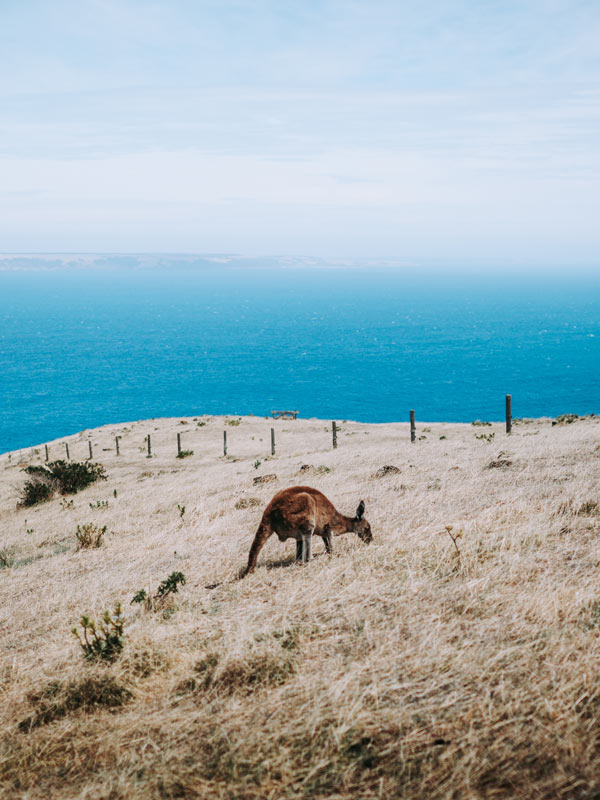
Explore the wildlife in Deep Creek Conservation Park. (Image: Jessica Coulter)
Emerging from the wild tip, you’ll come to Victor Harbor, a vibrant small town nestled on the arc of Encounter Bay. Take a historic horse-drawn tram to Granite Island, famous for its boulder-laden landscape and its colony of little penguins, and board the rattling 1854 Cockle Train for a scenic journey to Goolwa, a historic port where the Murray River and Southern Ocean meet.
Return to Adelaide via the McLaren Vale wine region, stopping along the way to sample local drops at award-winning d’Arenberg or pretty-as-a-picture Down The Rabbit Hole.
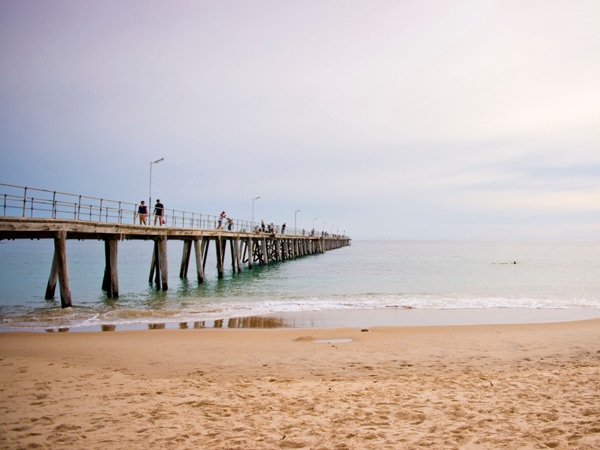
Go diving at Port Noarlunga in the Fleurieu Peninsula. (Image: South Australian Tourism Commission/Adam Bruzzone)
267 kilometres.
Disconnect at the completely isolated yet ultra-luxe Naiko Retreat (one of our 100 unique stays), an oceanfront stay atop the rolling hills of Deep Creek.
Words by Megan Arkinstall
My father was an avid storyteller who wrote a memoir detailing his childhood in Port Lincoln. The book, his passing five years ago and the fact I’d never visited his birthplace inspired me to make a nostalgic trip to South Australia’s Eyre Peninsula.
My friend and I set off south down the east coast, starting at Whyalla on the shores of the upper Spencer Gulf. We soak in 360-degree views from Hummock Hill and circuit the seaport’s uniquely circular shaped jetty, where a mosaic cuttlefish sculpture nods to the giant cuttlefish migration that can be witnessed here between May and August.
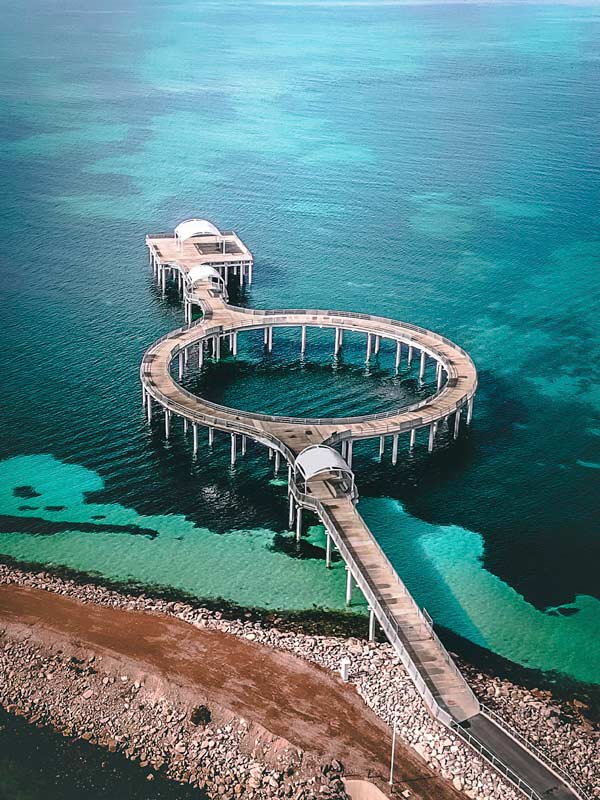
Whyalla Jetty is a sight for sore eyes. (Image: Tommy Woods Photography)
An hour further south, we stop at Cowell on Franklin Harbour: one of the best fishing spots in the state, where we also find silo art that forms part of the South Australia Silo Art Trail and locally made jade jewellery available to purchase at the Cowell Jade Motel. And we continue to Tumby Bay, where my father was born in a small hospital that still stands on the pine-tree-lined foreshore.
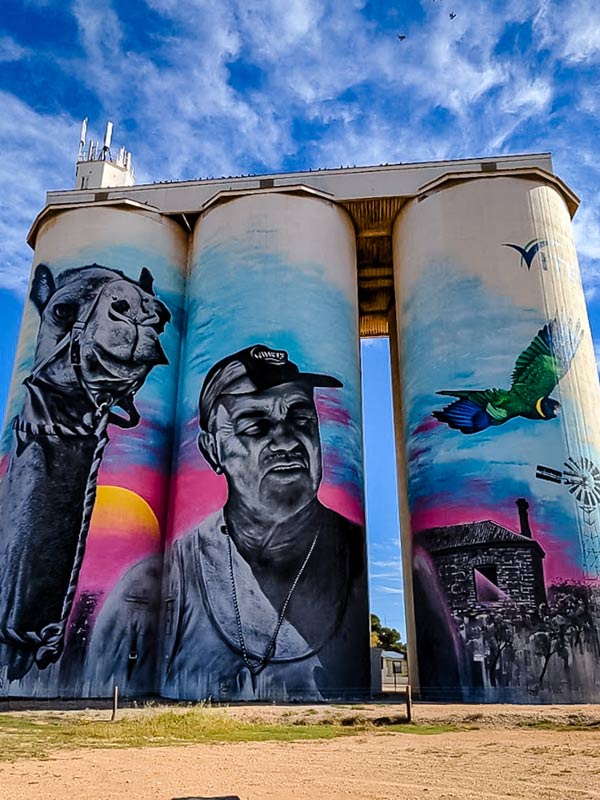
Eyre Peninsula Cowell Silo Mural of Shannon Noll and a camel. (Image: Jennifer Johnston)
The sleepy coastal town has an accessible walking trail that follows the foreshore past a wooden jetty whose pylons and ocean weed beds are home to a whimsical sea creature: the elusive leafy sea dragon. Though the only one we find is on a mural. Elsewhere, Tumby Bay’s silo art is a magical reflection of the seaside town by Argentinian artist Martin Ron.
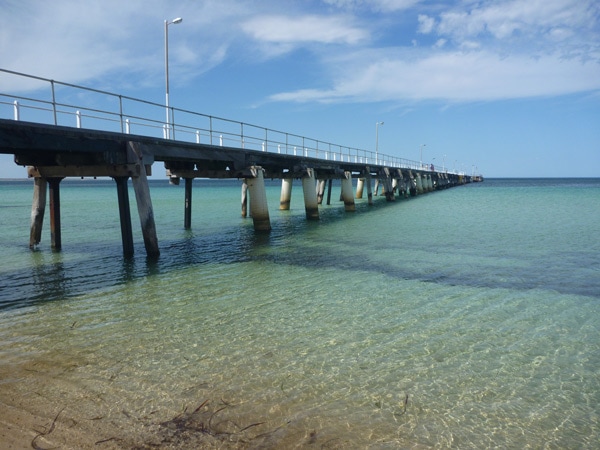
Walk the Tumby Bay Jetty to find the leafy sea dragon. (Image: Mark Phelps)
Then on to Port Lincoln and a stop at Limani Motel, where my father’s family home once stood. Looking out over the calm waters of Boston Bay – the largest natural harbour in Australia – I’m absorbed by his childhood view.
Outdoor adventures abound in and around this seafood capital, home to the biggest commercial fishing fleet in the southern hemisphere. In Lincoln National Park, we hike the 1.6 kilometres up Stamford Hill for spectacular views of the bay, and pad along pristine and secluded September Beach, speckled with granite boulders coated with orange lichen.

A drive through Lincoln National Park delivers the views. (Image: City of Port Lincoln)
The 1000-hectare wilderness sanctuary of nearby Whaler’s Way lies at South Australia’s southernmost tip; the roads are unsealed and rugged but the breathtaking coastal landscapes are worth every effort (pass required to visit).

Whalers Way is filled with charm. (Image: Kristy Billing @gypsyandherwild)
The tucked-away holiday haven of Coffin Bay, on the western side of the Eyre Peninsula’s tip, is most famous for one thing: following a speedy check-in at Coffin Bay Caravan Park, my oyster-loving friend scoots across the campgrounds to Oyster HQ. I arrive as she’s tucking into a dozen Coffin Bay oysters.
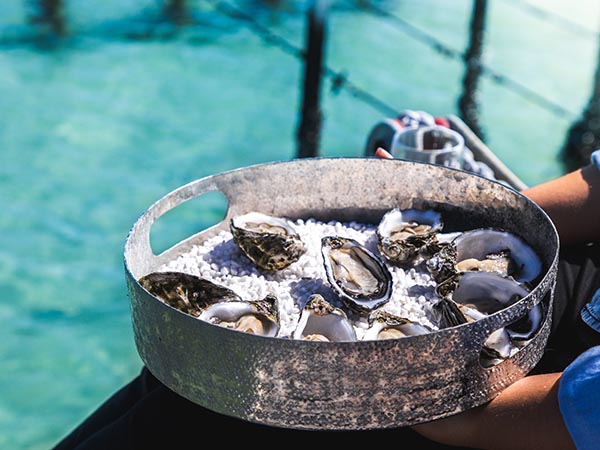
Experience freshly-shucked Coffin Bay oysters. (Credit: South Australian Tourism Commission)
After downing her second dozen, we walk part of the 15-kilometre Oyster Walk, which meanders through coastal vegetation with idyllic waters views and takes in the historical site of Old Oyster Town.
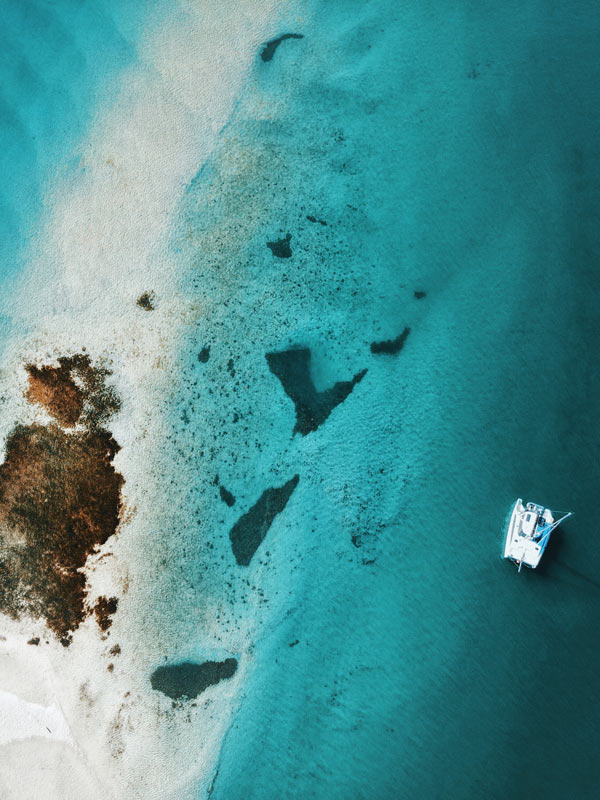
The pristine waters of Coffin Bay are to die for. (Image: Brodie Dufek)
On our final day we drive through Coffin Bay National Park. The wind is squally on Almonta Beach, but we persevere and revel in the Eyre Peninsula’s wild coastline one last time. My journey down this triangular land mass, wedged between the Great Australian Bight and the Spencer Gulf, has served up nostalgia in spades and many surprises besides.
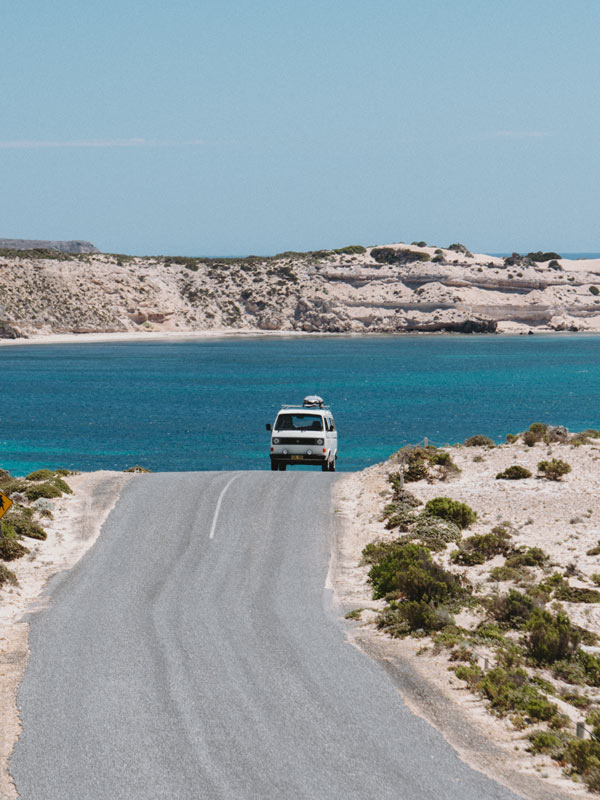
Drive your way through Coffin Bay National Park. (Image: Glenn Ferguson)
404 kilometres
Words by Jennifer Johnston
South Australia’s Yorke Peninsula extends out into the ocean not unlike Italy’s boot. Travel to its toe from Adelaide on a beach house pilgrimage taking in pink shack Love & Mutiny on the west coast and Bayside Glamping’s tiny house at Marion Bay, right at its tip.
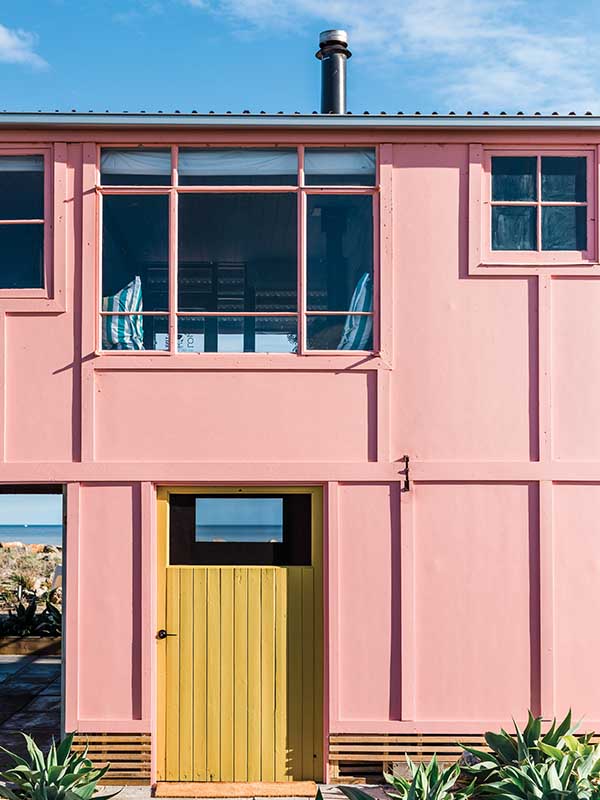
‘Love and Mutiny’ is a secluded beach shack that hosts fantastic views over the Yorke Peninsula. (Credit: Hannah Puechmarin)
324 kilometres
Outback drives don’t come more elemental than the one to and through South Australia’s majestic Ikara/Flinders Ranges National Park.
From Adelaide it is a 5.5-hour drive ever northwards to reach the park and the magnificence that is Wilpena Pound.
Known as Ikara in the language of the Adnyamathanha people, and meaning ‘meeting place’, the name hints at the deep cultural significance that this awe-inspiring natural wonder offers to those who have dwelt here for thousands of years.
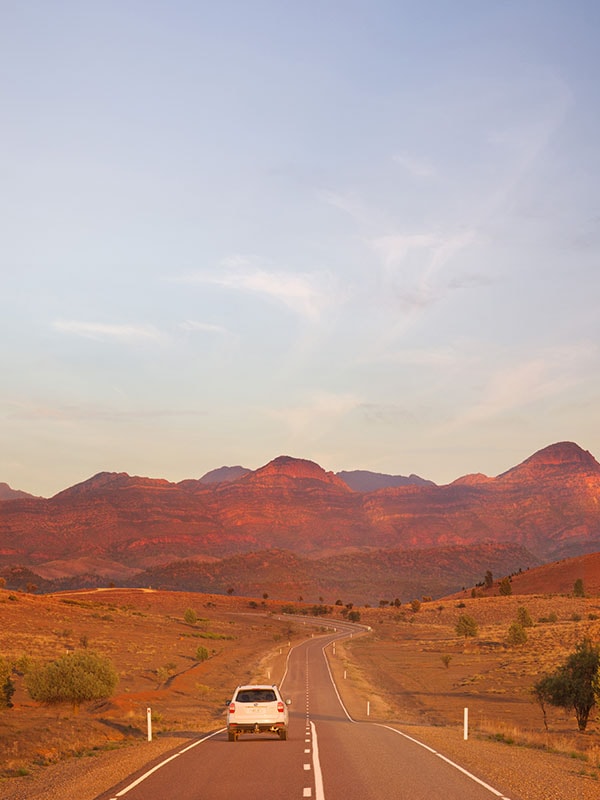
Feel the essence of the outback as you drive through the culturally significant site of Ikara/Wilpena Pound. (Image: Australian Tourism Commission)
Exploring this lunar landscape can involve everything from hikes to scenic flights to tracing Aboriginal Dreaming seams, and should be suitably indulged in over numerous days.
Luckily there are plentiful accommodation options that not only provide a comfortable (even luxurious) base, but also show due respect to the beauty and history of this truly unique landscape, from Wilpena Pound Resort to Rawnsley Homestead to Arkaba.
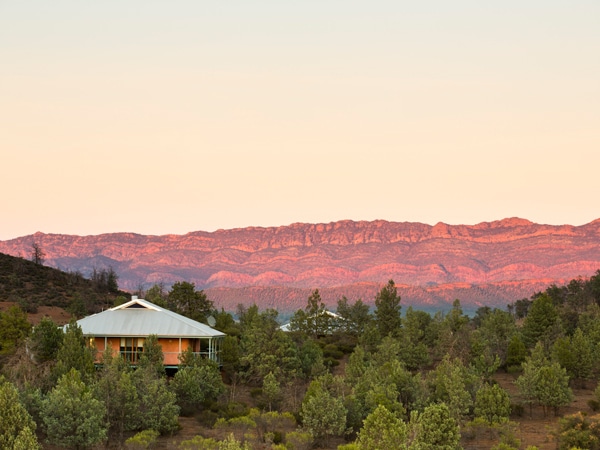
Sunset on the Elder Range from the Eco Villas at Rawnsley Park.
Roughly 450 kilometres from Adelaide to Ikara/Flinders Ranges National Park.
From geological wonders such as dazzling blue lakes and sinkholes, to some of the country’s best food and wine (think award-winning wagyu and robust reds to pair perfectly), and quintessential seaside towns to slow down in, South Australia’s Limestone Coast has something to offer all road-trippers.
Drive along the state’s south-east edge from the saline lagoon of Coorong National Park all the way to the Victorian border, stopping at Robe’s 12-kilometre-long Long Beach, for some of Australia’s best sand driving.
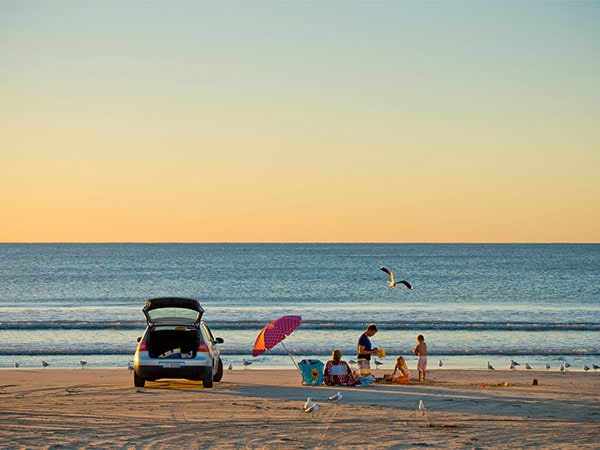
Enjoy the sunset along the picturesque coast. (Image: South Australian Tourism Commission)
The Limestone Coast stretches for more than 400 kilometres; extend your trip by following the Southern Ocean Drive, which also takes in Kangaroo Island and the Fleurieu Peninsula.
Constructed with materials salvaged from local shipwrecks, lovingly restored Airbnb Mrs Banks is the second oldest house in Robe.
Kangaroo Island is not short on scenic routes: 1600 kilometres of sealed and unsealed roads link its towns and beauty spots and meandering along them at your own pace is the best way to explore this South Australian gem. Start the journey on the mainland by catching the SeaLink vehicle ferry from Cape Jervis or hire a car on arrival.
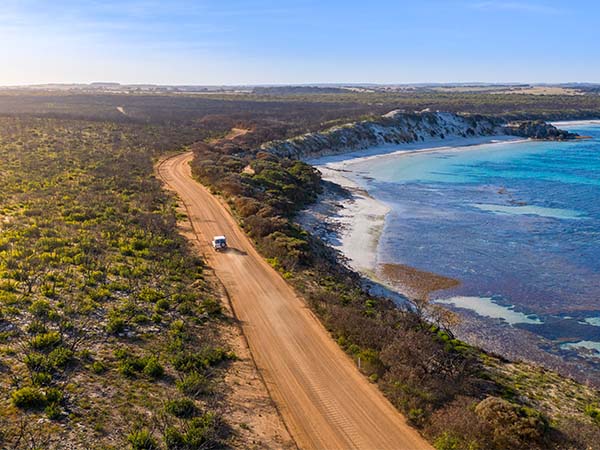
Trace the captivating coast on Kangaroo Island. (Image: South Australian Tourism Commission)
1600 kilometres
Take your pick of one of Lifetime Private Retreats’ geographically blessed beach houses.
This achievable Adelaide-to-Adelaide outback odyssey is an all-in antidote to everyday life: stuffed with whimsical things you’d never thought you’d see, from horizonless lakes that become the sky-to-desert outposts that tussle for survival with singular spirit and personality.
From Adelaide, wend your way north through Yorke Peninsula’s snoozy coastal hamlets before the gradual climb into the fetching Flinders Ranges. Pause for a couple of days to digest the majesty of the ranges’ spiritual ticker, the marvellously grand Ikara (Wilpena Pound).
As the Ranges melt into the plains to the north, you must pull into Australia’s fairest outback pub, Parachilna’s Prairie Hotel, for a Feral Mixed Grill (camel sausage, kangaroo fillet, emu mignon) and a wine/beer of transcendent provenance.
From here, the South Australian outback rolls out before your eyes, punctuated by towns that were once proud vertebrae in the Central Australia Railway backbone, stomping ground of those legendary nation-builders, the Afghan cameleers.
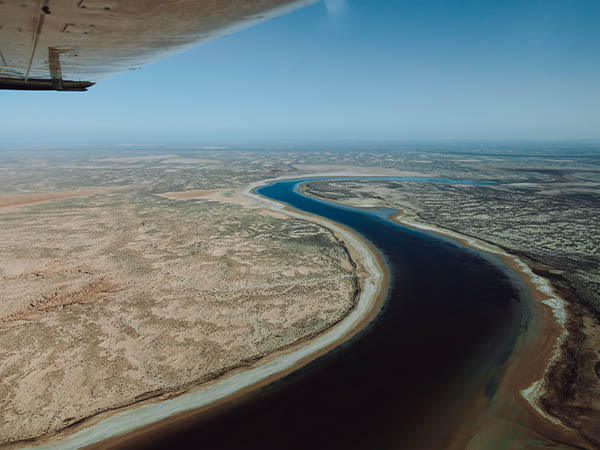
A taste of rural South Australia on the Oodnadatta Loop. (Image: South Australian Tourism Commission)
If the big board at Marree says ‘open’, you’re ready to tackle a section of the Oodnadatta Track; stage left at the Lake Eyre Yacht Club (yes, really). You don’t need a military-grade 4WD or to be a four-wheel-driving nerd, but be prepared: carry water, spares tyres (deflate as required), notify people when you should be expected, and defer to locals for road goss.
Keep an eye out for the Mutonia Sculpture Park – which is marked by two planes that mirage tail first from the red dirt – before you reach Kati Thanda-Lake Eyre-front William Creek Hotel, a quintessentially offbeat outback watering hole and headquarters for flights over Australia’s grandest salt lake that depart from its nearby airstrip.
Head up to Oodnadatta (if you have time) and down (or cut across directly) to opal-mining anomaly Coober Pedy, with its underground churches and hotels, and proudly shady characters who don’t care what you think but are glad you came.

Take a trip to Coober Pedy and discover the opal capital of the world.(Image: South Australian Tourism Commission)
After a couple of eccentric days in CP, hit the tarmac back to Adelaide, stocking up on Clare Valley Riesling on the way through if you’re still feeling frisky.
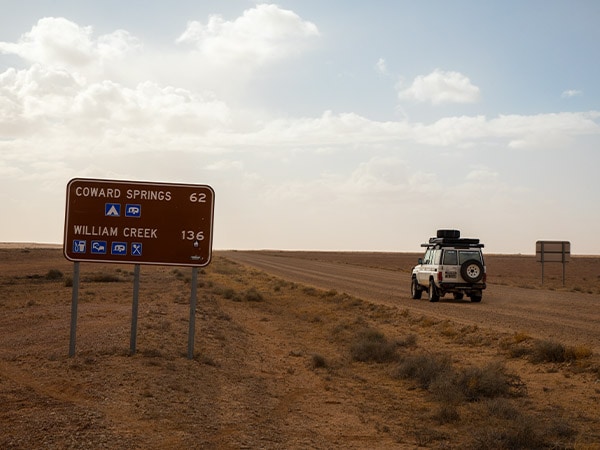
Witness the changing colours of the earth on the open dirt road. (Image: South Australian Tourism Commission)
1900 kilometres round trip (route dependent)
Words by Steve Madgwick
Hit the road northeast from Adelaide to indulge in some of Australia’s most renowned food and wine experiences, beginning at the western end of the Seppeltsfield Road precinct with its striking Avenue of Palms crying out to be cruised along. This five-kilometre trail of Canary Island date palms that now number more than 2000 was originally planted by Seppeltsfield workers during the Great Depression; visit the historic winery today to taste your birth year’s tawny, have lunch at destination diner Fino or even swap four wheels for two on a vineyard Segway tour. Other nearby epicurean highlights include Appellation and Hentley Farm restaurants and Maggie Beer’s Farm Shop. If this only whets your appetite for more, embark on the Epicurean Way: a decadent road trip through South Australia’s four iconic wine regions.
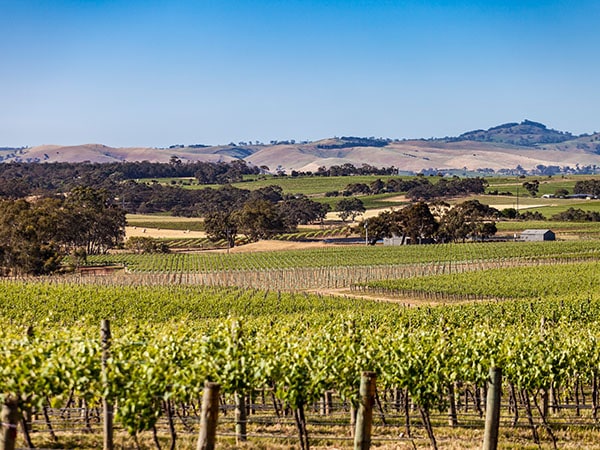
Indulge in some of Australia’s most renowned food and wine experiences.
Adelaide to Seppeltsfield Road is 80 kilometres.
In the heart of the Seppeltsfield Road precinct, The Villas – Barossa provides an architecturally striking and environmentally sensitive base for road-tripping the region.
The Saturday farmers market in Willunga packs up at noon, but even after a sleep-in and a crossword I still arrive with time to spare thanks to the wormhole-like Southern Expressway that whisks me through Adelaide’s southern suburbs to McLaren Vale. Growers and makers of every type cram into the local schoolyard, and I follow my nose (and the crowds) to the toastie stall for a gooey late breakfast.
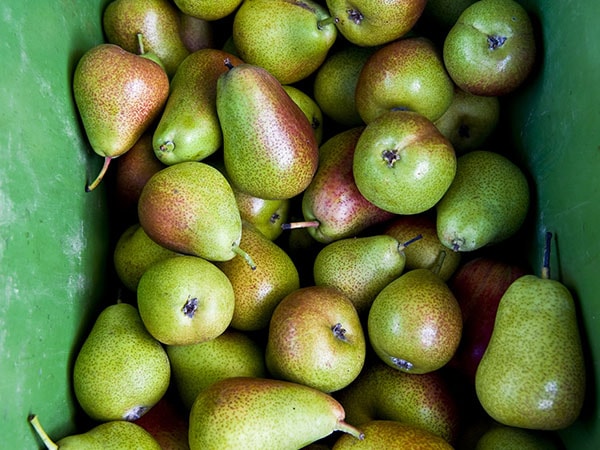
Grab some fresh pears at Wilunga Farmers Market. (Image: Karen Walker)
The friendly community vibe continues five minutes away at the McMurtrie Road ‘share house’, where three fabulous smaller wineries (Lino Ramble, Bondar Wines and Sherrah Wines) have a room each. Continuing east, the sea of vines parts as if for Moses and reveals a path to Gemtree Wines’ solar-powered cellar door where perfumed biodynamic grenache vies for my attention with glorious views out towards a sea the colour of Peter O’Toole’s eyes.
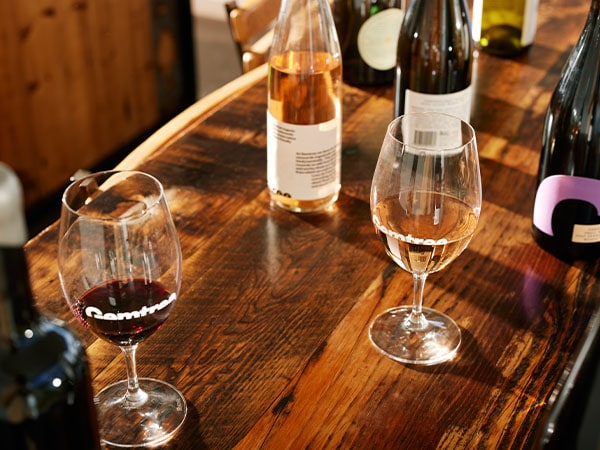
Go on a tasting at Gemtree Wines. (Image: South Australian Tourism Commission)
100 kilometres round trip.
Lean into slow living at CABN X William, located between Gemtree’s vineyards and thick bush.
Words by Alexis Buxton-Collins
Those with a penchant for pedalling through picturesque landscapes, preferably with the reward of a glass of something crisp at the end, should make tracks for South Australia’s Clare Valley wine region, which has established itself as one of the country’s most attractive cycling spots. It’s most famous for its Riesling Trail, which winds for 33 kilometres through vineyards, farmland and bushland punctuated by cellar doors and villages; it was established in 1994 from an old railway line that was damaged in the Ash Wednesday bushfires some 11 years earlier. Those looking for something a little less languid and more challenging can embark on the 900-kilometre Mawson mountain bike trail, which cuts through Clare on its way from the Flinders Ranges to the Adelaide Hills.
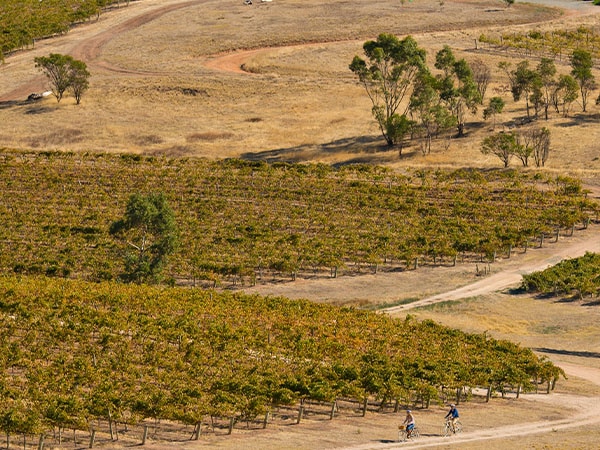
Make tracks for South Australia’s Clare Valley wine region. (Image: South Australian Tourism; Adam Bruzzone)
Route dependent
In a cottage at historic farming property Bungaree Station.
Adelaide Central Market is the city’s most-visited attraction. After visiting the sprawling undercover market, head for the Adelaide Hills via the South Eastern Freeway to sample the produce in situ. You can also explore the city’s bordering foothills via the Torrens Valley Scenic Drive, which starts in Tea Tree Gully, winds its way past the Chain of Ponds to Gumeracha and Birdwood, or via the Onkaparinga Valley Scenic Drive, where you can bounce along quiet country roads that stretch between the charming German village of Hahndorf to Birdwood in the north.
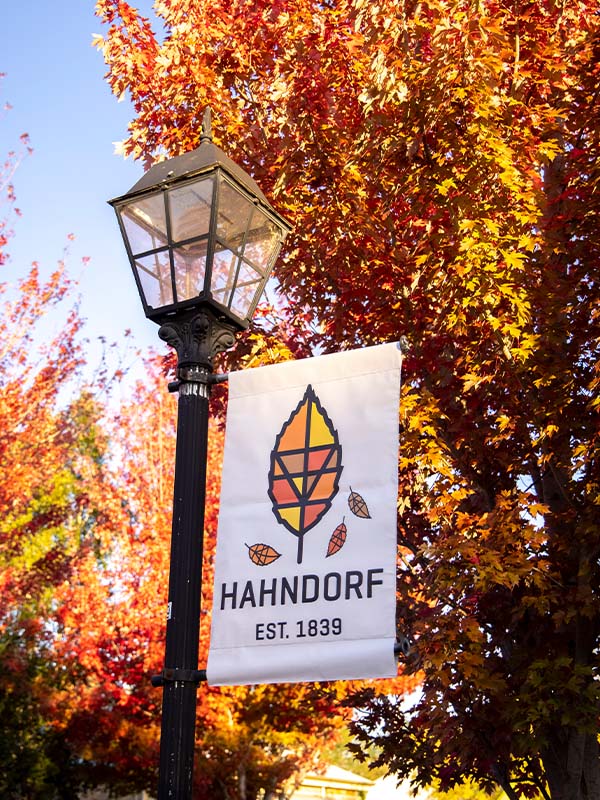
Explore the quaint and charming village of Hahndorf. (Image: South Australian Tourism Commission)
Download the Epicurean Way road trip map to plot your course between artisan growers and producers, much-lauded wineries, berry farms, microdistilleries, farmers markets, cheesemongers and restaurants showcasing the region’s bounty. Darlings of the Adelaide Hills include Woodside Cheese Wrights, Penfolds Magill Estate and cool collective Lot 100 (home to a paddock-to-plate eatery, 78° Distillery, Hills Cider Company, Mismatch Brewing Co and more). Sign up with Ultimate Winery Experiences Australia if you want a designated driver.
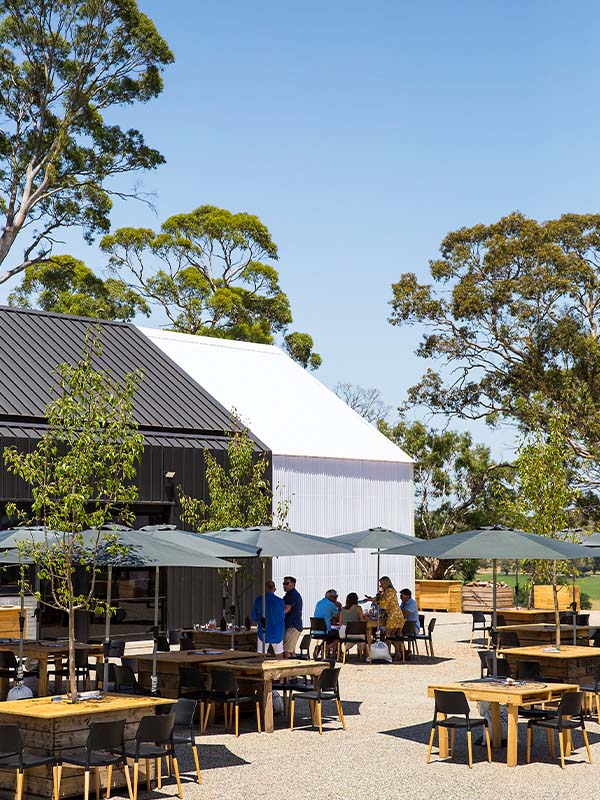
Graze at Lot 100– a former cattle pasture transformed into a craft brewery and unique food and beverage destination. (Image: South Australian Tourism Commission)
56-kilometre round trip along the South Eastern Freeway.
Return to Adelaide to stay and play at The Playford.
Words by Carla Grossetti
LEAVE YOUR COMMENT